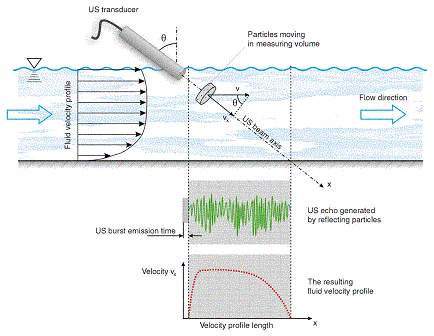Ultrasonic Velocity Profile (UVP) Monitor
Upgrade of model UVP-3-XW by new UVP DUO-MX by turn of years 2005/2006. The information about new features of UVP DUO-MX follow.
In case of your interest and detailed information don't hesistate to contact responsible person Ing. Vojtech Bareš
Examples of measurements
Visualization of 2D flow on physical model of CSO (Combined Sewer Overflow)Velocity vector map of 2D flow in CSO - comparison with numerical simulation (FLUENT)
Visualization of 2D unsteady flow in circular conduit
Distribution of horizontal velocities in open-channel flow – measured from water surface to bottom
Distribution of horizontal velocities in open-channel flow – measured trough wall
Flow map – river model 1
Flow map – river model 2
Ultrasonic Velocity Profile Monitor UVP-XW-PSi

The Ultrasonic Velocity Profiler (UVP) developed by MET-FLOW, S.A. is a measuring instrument that deals with all measurement conditioning and acquisition within a single device managed by a Digital Signal Processor (DSP), connected to one or several transducers thanks to an optional multiplexer.
Actually the technique detects the Doppler shift frequency information contained in the ultrasound echoed by particles contained in the fluid as a function of time. The measurement is unidimensional (1D) providing a velocity profile projected along the probing axis. The combination of several measurement axis can generate a bi-dimensional flow field (2D) or even a tri-dimensional one (3D).
Basic principle of measurements
An ultrasonic transducer transmits a short emission of ultrasound (US), which travels along the measurement axis Lm, and then switches over to receiving ('listening'). When the US pulse hits a small particle in the liquid, part of the US energy scatters on the particle and echoes back.

Main features of UVP DUO-XW
Department DSEE owns UVP Monitor Model UVP DUO-MX, which replaced former version UVP-3-XW. Main features of the new UVP DUO-MX are:
- New architecture with remote control from host computer
- Five selectable frequencies for wide application range
- Signal quality on-line display
- Measurement window from 10 to 2048 channels
- Turbulent statistics, histograms, correlations, power spectra
- New sensitive FFT Doppler-evaluation algorithm
- Integrated flow field mapping with up to 20 transducers
- Compact, sturdy, and lightweight design
DSEE owns following transducers
| ps | active Ć v mm | length v mm | |
| 4 MHz | 15 | 5 | 36.5 - 80 |
| 2 MHz | 5 | 10 | 60 |
| 1 MHz | 3 | 13 | 60 - 80 |
Measuring range for given basic frequencies:
f0 .................basic frequency
Pmax.............spatial measuring range
Vmax............velocity measuring range
DV..............accuracy of measurement
| f0 [MHz] | Pmax [mm] | Vmax [mm/s] | DV [mm/s] |
| 1 | 100 | 2.632 | 20.7 |
| 750 | 362 | 2.9 | |
| 2 | 100 | 1 316 | 10.4 |
| 750 | 181 | 1.4 | |
| 4 | 100 | 658 | 5.2 |
| 750 | 91 | 0.72 |
- values are valid for sound velocity c = 1480 m/s